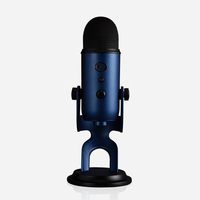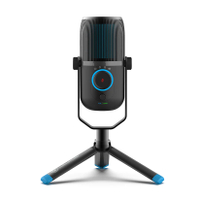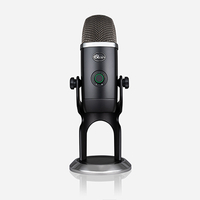And you won’t just sound better for the sake of it. How many times has a friend or teammate piped up on voice chat, only to bark gibberish that sounds like it came from the deep end of a wind tunnel? The best gaming mics can give you a competitive advantage when communication is paramount, so read on to find out which ones impressed us most in testing.
Top 3 best gaming microphones
The best gaming microphones you can buy today
There are newer gaming microphones, and there are cheaper gaming microphones. On the whole, the Blue Yeti is still better than any of them. The recording quality is good enough for semi-professional recording, let alone in-game voice chat or Discord banter, but it’s still as simple to set up and use as PC microphones come. You can’t adjust the stand height but tilting is enough to get the Yeti in a comfortable position, and you can always use the stand mount to substitute your own choice of mic arm. The Blue Yeti is popular with everyone from part-time PC gamers to famous streamers, and it’s not hard to see why. Read our full Blue Yeti review. If you can’t stretch the few extra dollars for the Blue Yeti, the JLab Talk is a seriously good alternative. It picks up speech with warmth and depth, and works well as soon as you plug in the USB cable — though a touch of extra gain doesn’t hurt. We also like how the holding tripod stand can be manipulated to provide a degree of height adjustment, something even the Blue Yeti doesn’t have. This stand does require a little more room on your desk, so keep that in mind if you’re going to play with it sat in front of your keyboard. Again, you can always attach it to an arm-style stand instead. Read our full JLab Talk review. It makes sense that an upgraded version of the best gaming microphone would also rank highly. The Yeti X doesn’t provide drastically improved sound, but does manage to take the Yeti’s broad design and make it even easier to use. For example, the Yeti X moves the gain control from the rear of the microphone chassis to the front, so it’s easier to both access and make fine adjustments too. The design also incorporates an LED display to show your mic input volume, so you don’t have to worry about whether you’re coming through loud and clear in the middle of a game. The standard Blue Yeti’s lower price is enough to keep it at the #1 spot, but the Yeti X’s tweaks can be useful. Read our full Blue Yeti X review. Gaming hardware is awash with RGB lighting, from the best gaming keyboards to humble RAM modules. RGB microphones aren’t so common, but if you do wish to color-coordinate your mic with other custom lighting in your PC setup, the HyperX QuadCast S is the best gaming microphone for the job. The entire grille can light up in whichever hues you choose, and that flashiness is backed up by strong performance. The QuadCast S sounds great even without any special setup, and it even includes an integrated pop filter and shock mount. The latter prevents accidental bumps from creating loud, annoying noises for whoever’s listening, so could be handy if you’re keeping your mic close to your mouse and keyboard. Read our full HyperX QuadCast S review. The Wave: 3 is more of a streamer’s tool than a generalist gaming microphone; it’s built to integrate with the Elgato Stream Deck controller, and uses the Wave Link desktop app to let the user manage different sound sources. Perhaps not the features you’d be using if you were to just play games with the webcam off. But even if you don’t stream, a lot of the Wave: 3’s other qualities translate well into everyday use. It sounds great, for starters, and ultimately it is another user-friendly USB microphone — not some professional mic with an XLR connector. Just be sure to position it correctly, as even the cardioid recording pattern can pick up background noise like mechanical keyboard clicks. Read our full Elgato Wave: 3 review. Sitting somewhere between the standard Blue Yeti and the Blue Snowball Ice, the Blue Yeti Nano aims to offer to the same recording quality as namesake — but in a smaller package, and at a lower price. Sure enough, the Blue Yeti Nano sounds great and remains enticingly affordable. The JLab Talk delivers slightly better audio, a couple of extra directional patterns and an adjustable stand, but the Nano is still a respectable alternative. Cardioid recording works well for gaming and streaming, while its omnidirectional mode caters for podcasts with multiple speakers. Read our full Blue Yeti Nano review. Like the Elgato Wave: 3, the B20 bills itself as a streaming microphone. It’s not as laser-focused, though, so you won’t feel like you’re missing out if you just want to play privately. It’s actually got something for everyone, with a useful range of buttons and dials, easy setup over USB and optional software, EPOS Gaming Suite, for more advanced tweaks. This is worth a try if you want to poke around with noise gate and reverb controls. The B20 is also one of the cleanest-looking, grown-up gaming microphones on this list, which could appeal if you find the likes of the QuadCast S too garish. It’s relatively expensive, though, and sound quality is good but not exceptional. Read our full EPOS B20 review.
How to choose the best gaming microphone
The single most important aspect of a gaming mic is sound quality. In order to be a worthwhile investment, a dedicated microphone must represent a significant upgrade over headset mics. That’s why we often rate microphones with great sound quality over others that might have more bonus features or be made of more premium materials. These are nice to have, but ultimately it all comes down to how intelligible your microphone can make you. Especially in games, where your voice input might need to compete with a maelstrom of action, dramatic sound effects and potentially other players. Usability is important too, but frankly all the microphones on this list are very easy to install and use. Your secondary concern, then, should be price. In-between the $100 and $150 mark seems to be something of a sweet spot for the best gaming microphones. Of course, you can go lower, but your options will be more limited. Only go higher if, in addition to high sound quality, a microphone has specific features you desperately want and can’t find on cheaper models.
How we test the best gaming microphones
Because we’re primarily checking for sound quality, our testing process for any kind of microphone typically involves making some recordings and listening back to hear how we sound. This approach also lets us build a library of recordings that helps us make more meaningful comparisons between two competing mics, even if we didn’t originally test them at the same time. For gaming mics, there’s the added consideration of how they’ll sound in a VoIP setup as opposed to local recording. We’ll try to hop on a Discord channel with trusted friends, or use various games’ own voice chat, and ask others for feedback on how we sound. If a manufacturer recommends certain software to help manage the microphone, we’ll try that out as well, though the very best gaming microphones can get by on hardware alone. Once testing is completed, we rate the best gaming microphones based on our five-point system (1 = worst, 5 = best). Products that hit nearly every mark are awarded an Editor’s Choice badge. Next: Still not made your mind up? Check out the best cheap gaming headsets or find a versatile bargain with the best headphones with a mic for voice and video calls. Plus, we’ve also rated the best streaming microphones overall, and the best gaming keyboards for all play styles.

















title: “The Best Gaming Microphones In 2022” ShowToc: true date: “2022-11-29” author: “Hector Sanon”
And you won’t just sound better for the sake of it. How many times has a friend or teammate piped up on voice chat, only to bark gibberish that sounds like it came from the deep end of a wind tunnel? The best gaming mics can give you a competitive advantage when communication is paramount, so read on to find out which ones impressed us most in testing.
Top 3 best gaming microphones
The best gaming microphones you can buy today
There are newer gaming microphones, and there are cheaper gaming microphones. On the whole, the Blue Yeti is still better than any of them. The recording quality is good enough for semi-professional recording, let alone in-game voice chat or Discord banter, but it’s still as simple to set up and use as PC microphones come. You can’t adjust the stand height but tilting is enough to get the Yeti in a comfortable position, and you can always use the stand mount to substitute your own choice of mic arm. The Blue Yeti is popular with everyone from part-time PC gamers to famous streamers, and it’s not hard to see why. Read our full Blue Yeti review. If you can’t stretch the few extra dollars for the Blue Yeti, the JLab Talk is a seriously good alternative. It picks up speech with warmth and depth, and works well as soon as you plug in the USB cable — though a touch of extra gain doesn’t hurt. We also like how the holding tripod stand can be manipulated to provide a degree of height adjustment, something even the Blue Yeti doesn’t have. This stand does require a little more room on your desk, so keep that in mind if you’re going to play with it sat in front of your keyboard. Again, you can always attach it to an arm-style stand instead. Read our full JLab Talk review. It makes sense that an upgraded version of the best gaming microphone would also rank highly. The Yeti X doesn’t provide drastically improved sound, but does manage to take the Yeti’s broad design and make it even easier to use. For example, the Yeti X moves the gain control from the rear of the microphone chassis to the front, so it’s easier to both access and make fine adjustments too. The design also incorporates an LED display to show your mic input volume, so you don’t have to worry about whether you’re coming through loud and clear in the middle of a game. The standard Blue Yeti’s lower price is enough to keep it at the #1 spot, but the Yeti X’s tweaks can be useful. Read our full Blue Yeti X review. Gaming hardware is awash with RGB lighting, from the best gaming keyboards to humble RAM modules. RGB microphones aren’t so common, but if you do wish to color-coordinate your mic with other custom lighting in your PC setup, the HyperX QuadCast S is the best gaming microphone for the job. The entire grille can light up in whichever hues you choose, and that flashiness is backed up by strong performance. The QuadCast S sounds great even without any special setup, and it even includes an integrated pop filter and shock mount. The latter prevents accidental bumps from creating loud, annoying noises for whoever’s listening, so could be handy if you’re keeping your mic close to your mouse and keyboard. Read our full HyperX QuadCast S review. The Wave: 3 is more of a streamer’s tool than a generalist gaming microphone; it’s built to integrate with the Elgato Stream Deck controller, and uses the Wave Link desktop app to let the user manage different sound sources. Perhaps not the features you’d be using if you were to just play games with the webcam off. But even if you don’t stream, a lot of the Wave: 3’s other qualities translate well into everyday use. It sounds great, for starters, and ultimately it is another user-friendly USB microphone — not some professional mic with an XLR connector. Just be sure to position it correctly, as even the cardioid recording pattern can pick up background noise like mechanical keyboard clicks. Read our full Elgato Wave: 3 review. Sitting somewhere between the standard Blue Yeti and the Blue Snowball Ice, the Blue Yeti Nano aims to offer to the same recording quality as namesake — but in a smaller package, and at a lower price. Sure enough, the Blue Yeti Nano sounds great and remains enticingly affordable. The JLab Talk delivers slightly better audio, a couple of extra directional patterns and an adjustable stand, but the Nano is still a respectable alternative. Cardioid recording works well for gaming and streaming, while its omnidirectional mode caters for podcasts with multiple speakers. Read our full Blue Yeti Nano review. Like the Elgato Wave: 3, the B20 bills itself as a streaming microphone. It’s not as laser-focused, though, so you won’t feel like you’re missing out if you just want to play privately. It’s actually got something for everyone, with a useful range of buttons and dials, easy setup over USB and optional software, EPOS Gaming Suite, for more advanced tweaks. This is worth a try if you want to poke around with noise gate and reverb controls. The B20 is also one of the cleanest-looking, grown-up gaming microphones on this list, which could appeal if you find the likes of the QuadCast S too garish. It’s relatively expensive, though, and sound quality is good but not exceptional. Read our full EPOS B20 review.
How to choose the best gaming microphone
The single most important aspect of a gaming mic is sound quality. In order to be a worthwhile investment, a dedicated microphone must represent a significant upgrade over headset mics. That’s why we often rate microphones with great sound quality over others that might have more bonus features or be made of more premium materials. These are nice to have, but ultimately it all comes down to how intelligible your microphone can make you. Especially in games, where your voice input might need to compete with a maelstrom of action, dramatic sound effects and potentially other players. Usability is important too, but frankly all the microphones on this list are very easy to install and use. Your secondary concern, then, should be price. In-between the $100 and $150 mark seems to be something of a sweet spot for the best gaming microphones. Of course, you can go lower, but your options will be more limited. Only go higher if, in addition to high sound quality, a microphone has specific features you desperately want and can’t find on cheaper models.
How we test the best gaming microphones
Because we’re primarily checking for sound quality, our testing process for any kind of microphone typically involves making some recordings and listening back to hear how we sound. This approach also lets us build a library of recordings that helps us make more meaningful comparisons between two competing mics, even if we didn’t originally test them at the same time. For gaming mics, there’s the added consideration of how they’ll sound in a VoIP setup as opposed to local recording. We’ll try to hop on a Discord channel with trusted friends, or use various games’ own voice chat, and ask others for feedback on how we sound. If a manufacturer recommends certain software to help manage the microphone, we’ll try that out as well, though the very best gaming microphones can get by on hardware alone. Once testing is completed, we rate the best gaming microphones based on our five-point system (1 = worst, 5 = best). Products that hit nearly every mark are awarded an Editor’s Choice badge. Next: Still not made your mind up? Check out the best cheap gaming headsets or find a versatile bargain with the best headphones with a mic for voice and video calls. Plus, we’ve also rated the best streaming microphones overall, and the best gaming keyboards for all play styles.
















